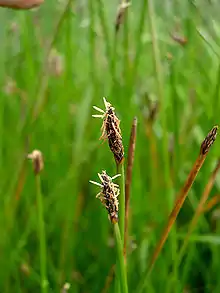Eleocharis macrostachya
Eleocharis macrostachya is a species of spikesedge known by the common name pale spikerush.
| Eleocharis macrostachya | |
|---|---|
 | |
| Scientific classification | |
| Kingdom: | Plantae |
| Clade: | Tracheophytes |
| Clade: | Angiosperms |
| Clade: | Monocots |
| Clade: | Commelinids |
| Order: | Poales |
| Family: | Cyperaceae |
| Genus: | Eleocharis |
| Species: | E. macrostachya |
| Binomial name | |
| Eleocharis macrostachya | |
| Synonyms[2] | |
| |
It is widely distributed in North America and occurs in parts of South America.[2][3] It is a plant of varied moist habitats, including freshwater lakes and brackish marshes and ponds, ditches, vernal pools, and wet meadows.
Description
Eleocharis macrostachya is a rhizomatous perennial generally reaching heights between one half and one meter. It has bright green erect stems and straw-colored basal leaves. The top of each stem is occupied by a narrow, lance-shaped or cylindrical inflorescence. The spikelet is one or two centimeters long and has at least ten flowers, each covered with a purplish-brown bract. The fruit is a yellow or yellow-brown achene with a whitish cone-shaped tubercle on one end, measuring one or two millimeters long.[4]
Use in phytoremediation efforts
E. macrostachya has been studied as part of wetland restoration, as well as the removal of arsenic in groundwater via rhizofiltration as part of phytoremediation.[5][6] Wetlands have the capacity to remove many conventional contaminants from wastewater, even in highly saline water.[7] Olmos-Marquez (2012) identified E. macrostachya as having the greatest arsenic retention in an experimental wetland, suggesting that it acts as a rhizofiltrator.[8][9]
References
- Lansdown, R.V. (2016). "Eleocharis macrostachya". IUCN Red List of Threatened Species. 2016: e.T64311298A66891680. doi:10.2305/IUCN.UK.2016-1.RLTS.T64311298A66891680.en. Retrieved 24 December 2022.
- Kew World Checklist of Selected Plant Families
- "Eleocharis macrostachya". Germplasm Resources Information Network. Agricultural Research Service, United States Department of Agriculture. Retrieved 2013-01-22.
- Flora of North America, Eleocharis macrostachya Britton in J. K. Small, Fl. S.E. U.S. 184, 1327. 1903.
- Fraser, Alexandra; Kindscher, Kelly (2001-12-01). "Tree spade transplanting of Spartina pectinata (Link) and Eleocharis macrostachya (Britt.) in a prairie wetland restoration site". Aquatic Botany. 71 (4): 297–304. doi:10.1016/S0304-3770(01)00185-1. ISSN 0304-3770.
- Márquez, Mario Alberto Olmos; Rivero, Jesús Manuel Ochoa; Herrera, María Teresa Alarcón; Estrada, Eduardo Santellano; Vega-Mares, José Humberto; Aragón, María Cecilia Valles (2020). "Performance of a Pilot Subsurface Flow Treatment Wetland System, Used for Arsenic Removal from Reverse Osmosis Concentrate, in the Municipality of Julimes, Chihuahua, Mexico". Ingeniería y universidad (24): 10. ISSN 0123-2126.
- Berg, Elisa C.; Borges, Alisson C. (2020). "Use of plants in the remediation of arsenic-contaminated waters". Water Environment Research. 92 (10): 1669–1676. doi:10.1002/wer.1419. ISSN 1554-7531.
- Olmos-Márquez, Mario Alberto; Alarcón-Herrera, Maria Teresa; Martín-Domínguez, Ignacio Ramiro (2012-03-01). "Performance of Eleocharis macrostachya and its importance for arsenic retention in constructed wetlands". Environmental Science and Pollution Research. 19 (3): 763–771. doi:10.1007/s11356-011-0598-x. ISSN 1614-7499. PMID 21935698. S2CID 25907074.
- Ochoa-Rivero, J.M.; Olmos-Márquez, M.A.; Sáenz-Uribe, C.G.; Alarcón-Herrera, M.T. (2019-08-23). "Phytoremediation of arsenic using a chemical stabilizer and Eleocharis macrostachya in a contaminated mining soil". Environmental Arsenic in a Changing World. CRC Press. pp. 483–484. doi:10.1201/9781351046633-190. ISBN 978-1-351-04663-3. S2CID 213001998.
External links
- Jepson Manual Treatment: Eleocharis macrostachya
- USDA Plants Profile — Eleocharis macrostachya (pale spikerush)
- Eleocharis macrostachya — U.C. Photo gallery
- C.Michael Hogan ed. 2010. Eleocharis macrostachya. Encyclopedia of Life
